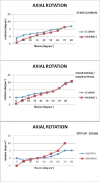Design and kinematics in total knee arthroplasty
- PMID: 24420156
- PMCID: PMC3923950
- DOI: 10.1007/s00264-013-2245-2
Design and kinematics in total knee arthroplasty
Abstract
Purpose: Posterior stabilised (PS) total knee arthroplasty (TKA) design development that focused on restoring normal knee kinematics was followed by the introduction of reason-guided motion designs. Although all PS fixed-bearing knee designs were thought to have similar kinematics, reports show they have differing incidences and magnitudes of posterior femoral rollback and axial rotation. In this retrospective comparative study between two guided-motion total knee systems, we hypothesised that kinematic pattern has an influence on clinical and functional outcomes.
Methods: This study represents the continuation of a previously reported clinical and kinematics analysis. We retrospectively reviewed 347 patients treated with two different TKA designs: Scorpio NRG (Stryker Orthopedics) and Journey Bi-Cruciate Stabilised (BCS) knee system (Smith & Nephew). Two hundred and eighty-one patients were assessed clinically. Patients were divided into groups according to implanted TKA. Clinical evaluation with the Knee Injury and Osteoarthritis Outcome Score (KOOS) questionnaire was performed. Fifteen Scorpio NRG and 16 Journey BCS patients underwent video fluoroscopy during stair climbing, chair rising/sitting and step up/down at six months of follow-up.
Results: At an average 29 months of clinical follow-up, patients with Journey BCS TKAs reported better clinical results. Stiffness was more frequently reported in the Journey group (5.2 % vs 1.2 %), whereas anterior knee pain was observed in the Scorpio NRG group (1.9 %) only. Both prosthetic models reported different posterior translation of the medial and lateral contact points (CP) in all analysed motor tasks during knee flexion (BCS 10-18 mm; NRG Scorpio 2-3 mm). Both designs produced progressive external rotation of the femoral component relative to the tibia during flexion.
Conclusions: Journey BCS showed statistically significant better KOOS results. The higher posterior femoral rollback observed in the kinematic assessment of this design, associated with a better patellofemoral design, may be the reason for better clinical outcome. The reported cases of stiffness and anterolateral joint pain could be attributed to excessive medial and lateral tibiofemoral posterior translation. The NRG group demonstrated good axial rotation, but this was not coupled with physiological kinematic patterns. Patellofemoral pain can be explained by a less friendly femoral-groove design. TKA clinical-functional outcome and complications were highly influenced by the bearing geometry and kinematic pattern of prosthetic designs.
Figures


Similar articles
-
Can TKA design affect the clinical outcome? Comparison between two guided-motion systems.Knee Surg Sports Traumatol Arthrosc. 2014 Mar;22(3):581-9. doi: 10.1007/s00167-013-2509-9. Epub 2013 Apr 30. Knee Surg Sports Traumatol Arthrosc. 2014. PMID: 23632757
-
Bicruciate-stabilised total knee arthroplasty provides good functional stability during high-flexion weight-bearing activities.Knee Surg Sports Traumatol Arthrosc. 2019 Jul;27(7):2096-2103. doi: 10.1007/s00167-019-05375-9. Epub 2019 Apr 10. Knee Surg Sports Traumatol Arthrosc. 2019. PMID: 30972466
-
Changes in total knee arthroplasty design affect in-vivo kinematics in a redesigned total knee system: A fluoroscopy study.Clin Biomech (Bristol). 2018 May;54:92-102. doi: 10.1016/j.clinbiomech.2018.03.014. Epub 2018 Mar 20. Clin Biomech (Bristol). 2018. PMID: 29573697
-
In vivo kinematics of medial unicompartmental osteoarthritic knees during activities of daily living.Knee. 2014;21 Suppl 1:S10-4. doi: 10.1016/S0968-0160(14)50003-8. Knee. 2014. PMID: 25382361 Review.
-
Influence of component design on in vivo tibiofemoral contact patterns during kneeling after total knee arthroplasty: a systematic review and meta-analysis.Knee Surg Sports Traumatol Arthrosc. 2021 Feb;29(2):446-466. doi: 10.1007/s00167-020-05949-y. Epub 2020 Apr 3. Knee Surg Sports Traumatol Arthrosc. 2021. PMID: 32242268
Cited by
-
Nontraumatic fracture of the polyethylene tibial post in a bi-cruciate stabilized total knee prosthesis.Arthroplast Today. 2019 Jul 23;5(3):284-287. doi: 10.1016/j.artd.2019.06.001. eCollection 2019 Sep. Arthroplast Today. 2019. PMID: 31516966 Free PMC article.
-
Total knee arthroplasty in Italy: reflections from the last fifteen years and projections for the next thirty.Int Orthop. 2019 Jan;43(1):133-138. doi: 10.1007/s00264-018-4165-7. Epub 2018 Oct 6. Int Orthop. 2019. PMID: 30293141
-
Maximal flexion and patient outcomes after TKA, using a bicruciate-stabilizing design.Arch Orthop Trauma Surg. 2020 Oct;140(10):1495-1501. doi: 10.1007/s00402-020-03491-7. Epub 2020 May 28. Arch Orthop Trauma Surg. 2020. PMID: 32468168
-
Short-term safety and effectiveness of a second-generation motion-guided total knee system.Arthroplast Today. 2018 Feb 16;4(2):240-243. doi: 10.1016/j.artd.2017.11.007. eCollection 2018 Jun. Arthroplast Today. 2018. PMID: 29896561 Free PMC article.
-
Similar kinematic patterns in posterior-stabilized and condylar constrained knee prostheses in revision knee arthroplasty: a prospective cohort study.J Orthop. 2025 Apr 22;64:153-162. doi: 10.1016/j.jor.2025.04.004. eCollection 2025 Jun. J Orthop. 2025. PMID: 40352782
References
-
- Gunston FH. Polycentric knee arthroplasty. Prosthetic simulation of normal knee movement. J Bone Joint Surg Br. 1971;53:272–277. - PubMed
Publication types
MeSH terms
LinkOut - more resources
Full Text Sources
Other Literature Sources
Medical
Miscellaneous

